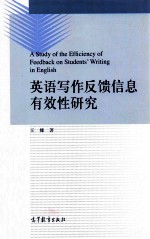

英语写作反馈信息有效性研究PDF电子书下载
- 电子书积分:10 积分如何计算积分?
- 作 者:王娜
- 出 版 社:北京:高等教育出版社
- 出版年份:2014
- ISBN:9787040395860
- 页数:248 页
第一章 引言 1
1.1 Research background 5
1.2 Objectives of the research 9
1.3 Research questions 10
1.4 Significance of the research 11
1.5 An overview of chapters 13
第二章 国内外英语写作教师反馈信息研究综述 15
2.1 Introduction 16
2.2 Definitions of feedback 16
2.3 Multi-perspectives on feedback 17
2.4 Types offeedback in English writing learning 18
2.5 Roles of feedback in English writing learning 20
2.6 Multiple views on teacher written feedback 20
2.7 Previous studies of teacher written feedback 21
2.7.1 A framework for reviewing feedback studies 22
2.7.2 Feedback studies in L1 context 24
2.7.3 Feedback studies in L2/FL context 31
2.7.4 Feedback studies in the Chinese EFL writing learning context 37
2.8 Summary 39
第三章 理论框架 41
3.1 Introduction 43
3.2 Relevant theories 43
3.2.1 Social learning theories 43
3.2.1.1 Lave & Wenger's Community of Practice theory 44
3.2.1.2 Vygotsky's Zone of Proximal Development 45
3.2.2 SLA theories 45
3.2.2.1 Selinker's Interlanguage theory 46
3.2.2.2 Krashen's Input Hypothesis 47
3.2.2.3 Krashen's Interaction Hypothesis 48
3.3 A working model for the current research 49
3.4 Efficiency of feedback 52
3.5 Summary 56
第四章 研究设计与方法 57
4.1 Issues to be addressed 58
4.2 General introduction to the whole project 58
4.2.1 Preliminary study 61
4.2.2 Main study 63
4.3 Summary 64
第五章 前期研究 65
5.1 Methods & procedures 67
5.2 Data collection 68
5.2.1 Data source 68
5.2.2 Data types 69
5.3 Data analysis 70
5.3.1 Data sorting 70
5.3.1.1 Principles & procedures 70
5.3.1.2 Teacher feedback on students'writing 71
5.3.1.3 Errors in students'writing 85
5.3.2 Data analysis 89
5.3.2.1 Analytical analyses of teacher feedback 90
5.3.2.2 Error analysis 107
5.3.2.3 Stabilizations in Chinese EFL learners'writing 130
5.4 Summary 131
第六章 主要研究 135
6.1 Research hypotheses 137
6.2 Methods & procedures 138
6.3 Subjects 139
6.4 Settings 140
6.5 Data collection 143
6.5.1 Students'texts 144
6.5.2 Electronic feedback 146
6.5.3 Students'revisions 151
6.5.4 A questionnaire survey 152
6.5.5 Students'responses to feedback 154
6.5.6 The writing instructor's evaluation of feedback 155
6.6 Data analysis 155
6.6.1 Analyzing the quality of students'texts 155
6.6.1.1 Analyzing structural organization 156
6.6.1.2 Analyzing range ofvocabulary 157
6.6.2 Analyzing students'revisions 157
6.6.3 Analyzing questionnaire data 157
6.6.4 Analyzing students'responses to feedback 158
6.6.5 Analyzing the writing instructor's evaluation of feedback 158
6.7 Summary 158
第七章 研究结果与分析 159
7.1 Introduction 161
7.2 Impacts of the e-feedback 161
7.2.1 Impacts on students'general writing ability 162
7.2.1.1 Analysis ofstructural organization 162
7.2.1.2 Analysis of diversity of vocabulary 163
7.2.2 Impacts on students'writing performance 165
7.2.3 Analysis of students'revisions 166
7.2.4 Students'responses to feedback 171
7.2.4.1 Students'attitudinal evaluation of feedback 172
7.2.4.2 Students'performance evaluation of feedback 184
7.2.5 The instructor's evaluation of feedback 187
7.2.6 Summary 187
7.3 New types of teacher&student relationships 188
7.3.1 New teacher identity & roles 189
7.3.2 New student identity & roles 190
7.4 A suggested model for Chinese EFL writing teachers 191
7.4.1 Focuses of feedback 194
7.4.2 Forms of feedback 195
7.4.3 Functions of feedback 196
7.5 Summary 197
第八章 结论与启示 199
8.1 Summary of major findings 202
8.2 Research products 206
8.2.1 A corpus of teacher feedback 206
8.2.2 E-feedback to stabilizations in Chinese EFL learners'writing 207
8.3 Limitations of the current research 208
8.4 Implications for Chinese EFL writing instructions 209
8.5 Conclusion 212
Bibliography 215
Acknowledgements 233
Appendix A:Examples of E-feedback 234
Appendix B:Questionnaires 238
Appendix C:Students'Responses to Feedback 245
- 《红色旅游的社会效应研究》吴春焕著 2019
- 《管理信息系统习题集》郭晓军 2016
- 《汉语词汇知识与习得研究》邢红兵主编 2019
- 《生物质甘油共气化制氢基础研究》赵丽霞 2019
- 《东北民歌文化研究及艺术探析》(中国)杨清波 2019
- 《联吡啶基钌光敏染料的结构与性能的理论研究》李明霞 2019
- 《异质性条件下技术创新最优市场结构研究 以中国高技术产业为例》千慧雄 2019
- 《《国语》和《战国策》词汇比较研究》陈长书著 2017
- 《中国制造业绿色供应链发展研究报告》中国电子信息产业发展研究院 2019
- 《信息系统安全技术管理策略 信息安全经济学视角》赵柳榕著 2020
- 《戏曲英语读写教程》董新颖,王娜,阙艳华,程艳,李静 2018
- 《Photoshop创意绘画设计》(日)井上能伎亚著;王娜译 2020
- 《基于学科核心素养的初中英语思维导图》何兰,王娜娜编 2018
- 《商务英语规划与教师培训研》王娜著 2018
- 《建筑节能技术》王娜主编 2013
- 《税务代理实务》崔艳辉主编;王娜,周颂副主编 2013
- 《新视野大学英语形成性测评 第1册》郭平建主编;王娜,刘华,刘庆华等编者 2013
- 《小学语文质量目标指南 五年级》窦桂梅总主编;胡兰主编;王艳,王娜娜,焦玫等分册主编;张华毓,刘建伟,叶红等编 2013
- 《小学语文质量目标指南 六年级》窦桂梅总主编;胡兰主编;王艳,王娜娜,焦玫等分册主编;张华毓,刘建伟,叶红等编 2013
- 《新视野大学英语形成性测评 第3册》郭平建主编;王娜,刘华,刘庆华等编者 2013
- 《全国高等中医药行业“十三五”创新教材 中医药学概论》翟华强 2019
- 《培智学校义务教育实验教科书教师教学用书 生活适应 二年级 上》人民教育出版社,课程教材研究所,特殊教育课程教材研究中心编著 2019
- 《指向核心素养 北京十一学校名师教学设计 英语 七年级 上 配人教版》周志英总主编 2019
- 《习近平总书记教育重要论述讲义》本书编写组 2020
- 《办好人民满意的教育 全国教育满意度调查报告》(中国)中国教育科学研究院 2019
- 《高等数学试题与详解》西安电子科技大学高等数学教学团队 2019
- 《北京生态环境保护》《北京环境保护丛书》编委会编著 2018
- 《教育学考研应试宝典》徐影主编 2019
- 《语文教育教学实践探索》陈德收 2018
- 《家庭音乐素养教育》刘畅 2018
